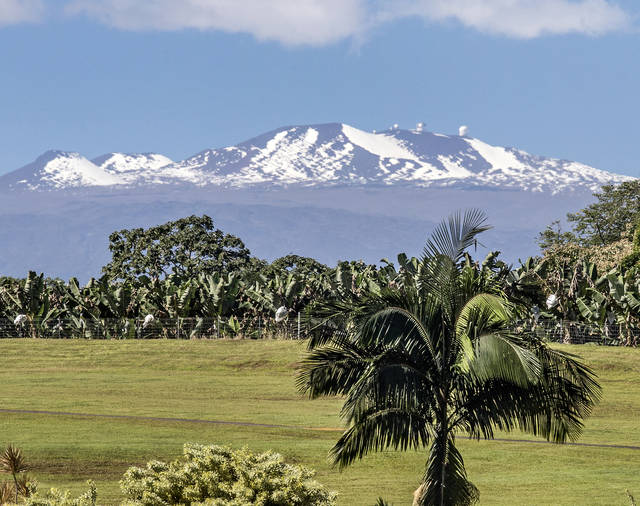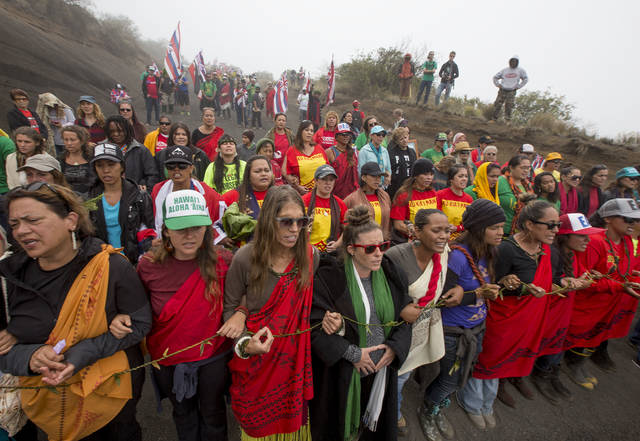HILO — While law enforcers are preparing a response to anticipated protests of the Thirty Meter Telescope on Maunakea, Mayor Harry Kim is talking to stakeholders, has assembled a committee of Hawaiian cultural leaders and released his vision statement for the mountain’s future.
“I don’t think there’s anything more important than us resolving this in a good way … meaning that it benefits the people of Hawaii and the world,” Kim said Monday. “Those are not just words to me.”
Attorney General Clare Connors told lawmakers last month Hawaii County will take the lead in the state’s response to protesters who attempt to interrupt construction of the telescope, which is expected to resume within the next few months.
Protests of the planned $1.4 billion observatory interrupted groundbreaking in 2014 and halted construction in 2015.
The state Supreme Court overturned its land-use permit because of due process violations. The high court in November, however, affirmed a new permit after another contested case hearing.
Deputy Police Chief Kenneth Bugado said Hawaii Police Department will take the lead in any enforcement action “since we have the most resources on the island.”
“Our main objective, of course, is to be sure there are no blockades or blockages in the road (to the summit),” Bugado said. “The opponents of the project have every right to protest, and we’re going to be sure to provide a safe area for the protesters, if they do want to protest the project.”
Some opponents, who call themselves “protectors” of Maunakea, said they plan to block construction vehicles again as they did in 2015. The mountain has cultural significance to Native Hawaiians, and some consider it sacred.
Bugado noted that while county police will take the lead, they will be assisted by officers from the state Sheriff’s Division and the Department of Land and Natural Resources.
Both state and county law enforcers responded to protesters blocking the Maunakea Access Road in 2015 outside and above the visitor information station. Arrests were made, but many charges were later dropped.
County police officers left after protesters reached the state-owned portion of the road near Halepohaku. Bugado affirmed county police will continue leading enforcement efforts on state property, as well.
Kim, meanwhile, said he has had discussions with the governor, attorney general, University of Hawaii Board of Regents, Office of Hawaiian Affairs, Kamehameha Schools, Keaukaha and Panaewa community associations, Liliuokalani Trust and other interested individuals in developing his “Vision for Maunakea” statement.
“For us to go forward, our main responsibility is to understand the whole issue of discontent,” Kim said, and added, “this is from 1893.”
That was the year the Kingdom of Hawaii was overthrown in a coup d’état by a group of businessmen and sugar planters, who forced Queen Liliuokalani to abdicate the throne.
“I think this is a very important issue for a lot of people in this state — and I’m not talking about the telescope. I’m talking about the polarization of people. And that is my biggest concern,” Kim said.
Kim’s statement said his vision is “about what Maunakea can be for the world.”
That vision statement, released to the Tribune-Herald on Monday, includes Maunakea as “a symbol of nations working together for the pursuit of peace and harmony,” as well as “a symbol of native Hawaiian heritage and the inseparability of nature and culture” and “a recognition of a deeply painful history of intrusions on the first Nation of Hawaii … .”
Kim’s Maunakea Core Committee includes: Chad Kalepa Baybayan, master navigator and a captain of the Polynesian Voyaging Society canoe Hokule‘a; Gregory Chun, Ph.D., Office of Maunakea Management board chairman and UH’s senior adviser on Maunakea; Lucille Chung of the Hawaiian Civic Club; Larry Kimura, associate professor of Hawaiian language at UH-Hilo; Kepa Maly, cultural ethnographer resource specialist at Lana‘i Culture and Heritage Center; and Ka‘iulani Pahio, director of community programs at Kanu o ka ‘Aina Learning ‘Ohana.
Kim said his mission is to get more people together and see if, somehow, “we can come to some kind of agreement.”
“I have yet to meet anyone who refused to talk to me,” he said. “I have yet to meet anyone where we parted in anger or frustration or anything like that, because the whole mission is to get them to understand what I’m trying to do.”
The mayor stressed that the state and county are working “together for the enforcement of the policies on Maunakea.”
“I know they are working to ensure that there’s harmony and no conflict in who does what,” Kim said.
Email John Burnett at jburnett@hawaiitribune-herald.com.


